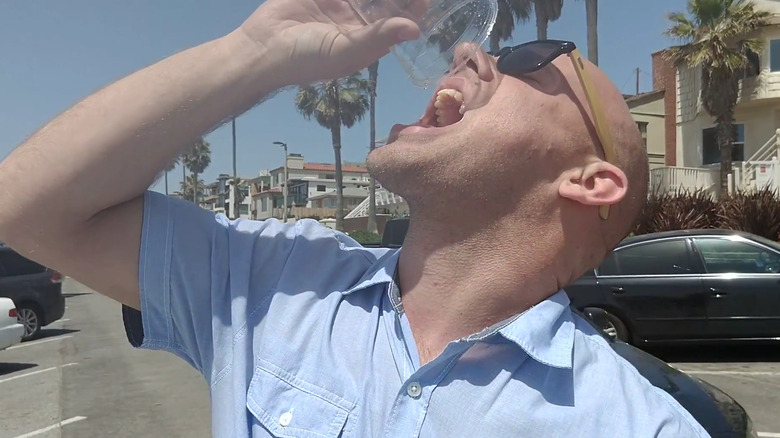Can You Really Drink The Exhaust Water From A Toyota Mirai?
Hydrogen has only recently been thoroughly explored as a consumer fuel option, and drivers have plenty of questions about car models like the Toyota Mirai, including "where would you fill up your car during a road trip," and apparently, "can you drink the exhaust water." That's been a question on some car enthusiasts' minds since the Mirai was introduced. Wired reporter Jeremy White decided to track down one of the 12 Mirai in Britain in 2016 and give it a shot. "We didn't die. In fact, it tasted fine, if a little warm," White reported. "But this little test really hits home how clean this kind of motoring is — the fact that you can drink what comes out of the tail pipe of your hydrogen car."
In July 2024, influencer The Fast Lane Car wanted to try it out for himself. He posted a video to Instagram drinking a glass of water right out of the Toyota Mirai's tailpipe. After getting a splash of the exhaust's backwash in a glass cup, he took a sip, grimaced, and told his followers that the water didn't have a taste but was quite warm. There seems to be a consensus from those brave enough to drink it. But should you really be drinking exhaust water from a hydrogen car? Probably not.
[embed-https://www.instagram.com/reel/C9nDhKOJiei/?utm_source=ig_embed&ig_rid=cd751f8f-2d56-4412-8ae3-59174714d880]
How do hydrogen cars like the Toyota Mirai work?
There are currently only three production hydrogen cars on the road despite hydrogen-powered vehicles existing since the 1950s. One of those vehicles is the Toyota Mirai. This vehicle only needs hydrogen and oxygen to produce energy. At a fueling station — of which there are currently 54 in the United States — hydrogen gets pumped into the vehicle. Meanwhile, oxygen enters through the intake grille. Both combine to produce electricity which propels the car and powers its systems.
This process results in just one by-product: water. There is no heat, smoke, or emissions. Instead, the water drips out of the tailpipe (and apparently into some people's cups). However, Toyota has warned people to not drink the Toyota Mirai exhaust water. The carmaker told Automotive News in 2016 that, while it believed the Mirai's exhaust doesn't have a lot of "impurities," it couldn't recommend drinking the water. "Depending on the place you are driving, some parts of the world might have certain issues, such as organisms like E. coli, which could be hazardous to your health. You never know what the quality of the air intake is."
Why are hydrogen cars not more popular?
Some drivers would think it's a no-brainer to start promoting hydrogen technology since it produces zero emissions. However, the Toyota Mirai wasn't really a big hit. It's considered the best-selling hydrogen car, but that is just a total of 24,982 units from 2022 to 2024 — including just 245 sold in the first half of 2024. That's far from Toyota's goal of selling 200,000 hydrogen vehicles by 2030. Still, Toyota plans to target China and Europe with hydrogen vehicles in the near future.
One major issue is the scarcity of fueling stations. Even California is losing some of the hydrogen fueling stations it previously had, with Shell pulling out of the business due to the difficulty of obtaining hydrogen for its pumps. This has been echoed all over the world — France has 80 total hydrogen pumps and China has just 400 which is nowhere near its original goal of over 1,200 hydrogen pumps by 2025.
The second issue is that a lot of scientists don't consider hydrogen cars to be "green" since the hydrogen currently doesn't come from a zero-emissions energy source like renewables. Right now, only 1% of hydrogen is considered green. It's also not considered efficient due to how much energy is wasted in the process and how difficult it can be to move hydrogen around. There are a lot of challenges — but Toyota and other carmakers are still trying.


